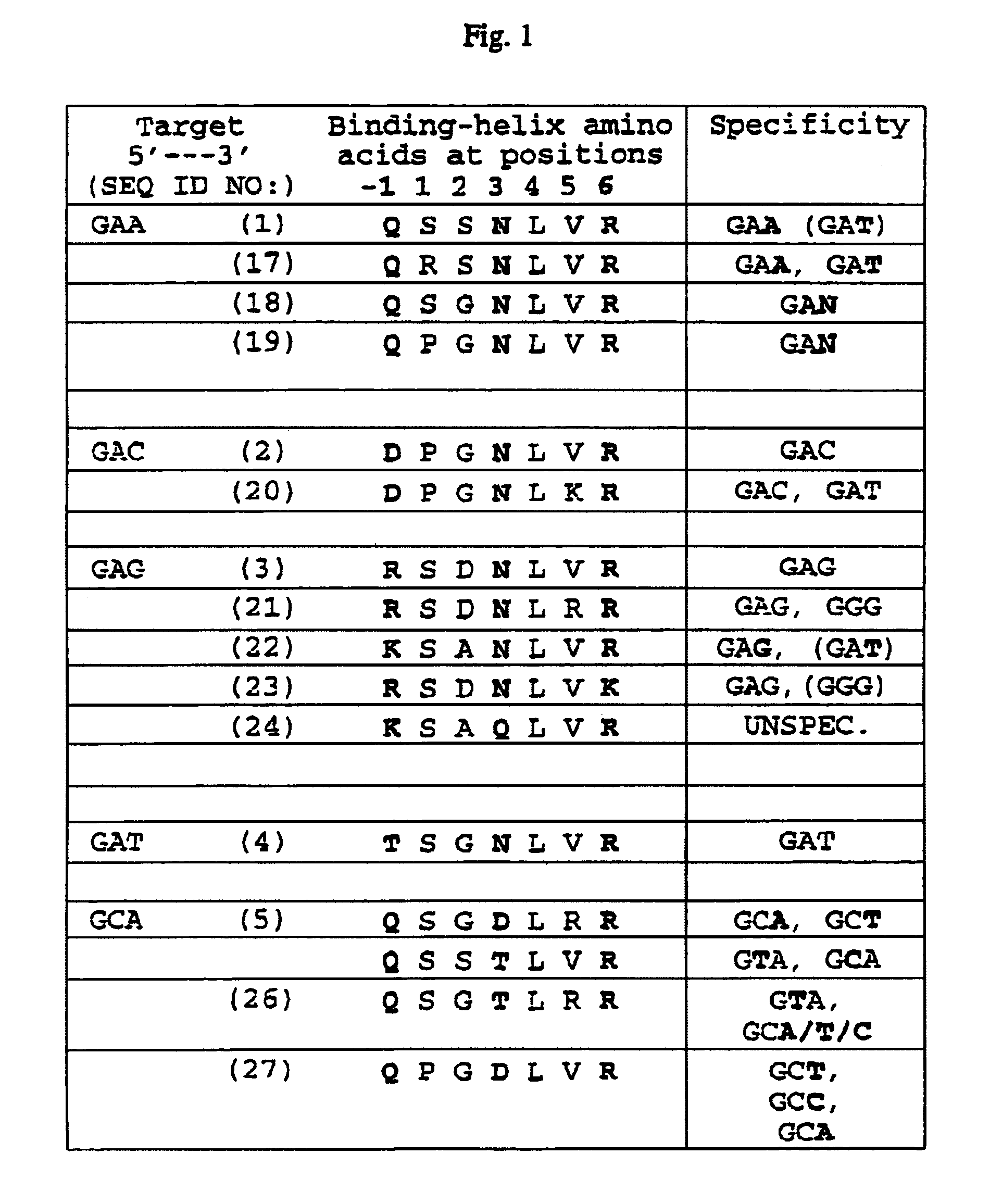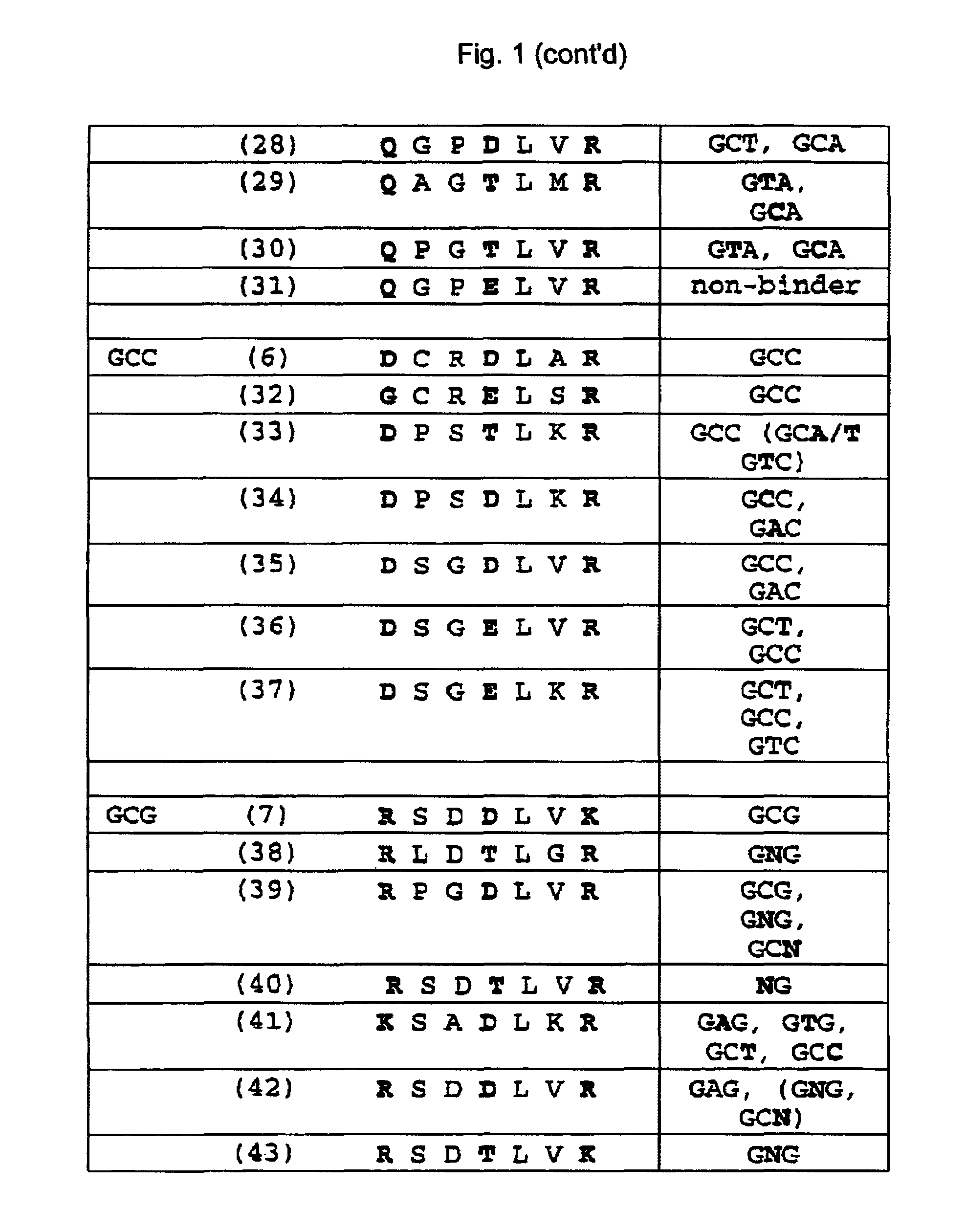Zinc finger binding domains for GNN
a zinc finger and binding domain technology, applied in the field of zinc finger protein binding, can solve the problems of not explaining if alternative interactions might be more optimal, little information is provided on how alternate sequences are excluded from binding, and each has its limitations. , to achieve the effect of rapid gene switching
- Summary
- Abstract
- Description
- Claims
- Application Information
AI Technical Summary
Benefits of technology
Problems solved by technology
Method used
Image
Examples
example 1
Selection by Phage Display
[0068]Construction of zinc-finger libraries by PCR overlap extension was essentially as previously described (Shi, Y. & Berg, J. M. (1996) Biochemistry 35, 3845–8). Growth and precipitation of phage were as previously described (Pengue, G. & Lania, L. (1996) Proc. Natl. Acad. Sci. USA 93, 1015–1020, Friedman, J. R., Fredericks, W. J., Jensen, D. E., Speicher, D. W., Huang, X.-P., Neilson, E. G. & Rauscher III, F. J. (1996) Genes &Dev. 10, 2067–2078), except that ER2537 cells (New England Biolabs) were used to propagate the phage and 90 μM ZnCl2 was added to the growth media. Precipitated phage were resuspended in Zinc Buffer A (ZBA; 10 mM Tris, pH7.5 / 90 mM KCl, 1 mM MgCl2, 90 μM ZnCl2) / 1% BSA / 5 mM DTT. Binding reactions (500 μl: ZBA / 5 mM DTT / 1% Blotto (BioRad) / competitor oligonucleotides / 4 μg sheared herring sperm DNA (Sigma) / 100 μl filtered phage (≈1013 colony forming units)) were incubated for 30 minutes at room temperature, prior to the addition of 72 nM...
example 2
Multi-target Specificity Assays
[0070]The fragment of pComb3H (Pengue, G. & Lania, L. (1996) Proc. Natl. Acad. Sci. USA 93, 1015–1020, Heinzel, T., Lavinsky, R. M., Mullen, T.-M., S{hacek over (s)}derstr{hacek over (s)}m, M., Laherty, C. D., Torchia, J., Yang, W.-M., Brard, G., Ngo, S. D. & al., e. (1997) Nature 387, 43–46) phagemid RF DNA containing the zinc-finger coding sequence was subcloned into a modified pMAL-c2 (New England Biolabs) bacterial expression vector and transformed into XL1-Blue (Stratagene). Freeze / thaw extracts containing the overexpressed maltose binding protein-zinc finger fusion proteins were prepared from IPTG-induced cultures using the Protein Fusion and Purification System (New England Biolabs). In 96-well ELISA plates, 0.2 μg of streptavidin (Pierce) was applied to each well for 1 hour at 37° C., then washed twice with water. Biotinylated target oligonucleotide (0.025 μg) was applied similarly.ZBA / 3% BSA was applied for blocking, but the well were not wash...
example 3
Gel Mobility Shift Assays
[0071]Fusion proteins were purified to >90% homogeneity using the Protein Fusion and Purification System (New England Biolabs), except that ZBA / 5 mM DTT was used as the column buffer. Protein purity and concentration were determined from Coomassie blue-stained 15% SDS-PAGE gels by comparison to BSA standards. Target oligonucleotides were labeled at their 5′ or 3′ ends with [32P] and gel purified. Eleven 3-fold serial dilutions of protein were incubated in 20 μl binding reactions (1× Binding Buffer / 10% glycerol / ≈1 pM target oligonucleotide) for three hours at room temperature, then resolved on a 5% polyacrlyamide gel in 0.5×TBE buffer. Quantitation of dried gels was performed using a Phosphorlmager and ImageQuant software (Molecular Dynamics), and the KD was determined by scatchard analysis.
PUM
| Property | Measurement | Unit |
|---|---|---|
| α- | aaaaa | aaaaa |
| hydrophobic interactions | aaaaa | aaaaa |
| structure determination | aaaaa | aaaaa |
Abstract
Description
Claims
Application Information
 Login to View More
Login to View More - R&D
- Intellectual Property
- Life Sciences
- Materials
- Tech Scout
- Unparalleled Data Quality
- Higher Quality Content
- 60% Fewer Hallucinations
Browse by: Latest US Patents, China's latest patents, Technical Efficacy Thesaurus, Application Domain, Technology Topic, Popular Technical Reports.
© 2025 PatSnap. All rights reserved.Legal|Privacy policy|Modern Slavery Act Transparency Statement|Sitemap|About US| Contact US: help@patsnap.com



